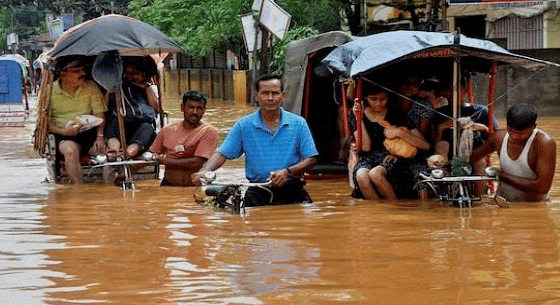Thank you dear subscribers, we are overwhelmed with your response.
Urban flooding has become a major concern for cities nationwide. In cities like Guwahati, where recurrent floods occur, the situation is particularly severe due to lack of integrated drainage networks and rapid, unplanned urban development. The city’s natural drainage system, primarily driven by the Bharalu-Bahani-Basistha River network, along with channels like Bondajan and Lakhimijan and water bodies such as Deepor Beel and Silsako, is overwhelmed by increasing runoff and insufficient infiltration.
A significant factor contributing to Guwahati’s flooding issues is the dramatic shift in land use patterns since the 1970s. The rapid urbanization which followed in the 90s, led to massive encroachments on low-lying wetlands and riverbanks, resulting in a reduction in forest cover, leading to artificial floods and waterlogging. Places in Guwahati such as Zoo Road and Dispur, which were once primarily under paddy cultivation or swamps, have now been developed into densely populated areas. As the city rapidly urbanized, the natural drainage systems had been converted into smaller streams or nullahs, which, simply, lack the capacity.
Flooding in Guwahati has far-reaching consequences. Recurrent floods lead to severe waterlogging, disrupt traffic, damage properties, and often result in long electricity outages. Flood risk is further compounded by unequal social vulnerability. Floodwaters also heighten the risk of waterborne diseases such as cholera, typhoid, and leptospirosis, and vector-borne diseases like dengue and malaria. Poor sanitation conditions during floods exacerbate health risks, particularly when the drinking water supply is compromised.
There are several reasons that explains Guwahati’s poor drainage. Drains have often been laid without proper gradients, and sometimes are placed across gradients, which makes them narrower preventing proper connection with the river network. There is a lack of a comprehensive sewage plan. The situation is exacerbated by the lack of a detailed drainage map or a comprehensive master drainage and sewerage plan, which leaves the city without clear directives on what measures need to be taken and where. On top of this, rainwater from Meghalaya comes in through inlets like the Bahini River and the Khanapara channel, significantly contributing to flash floods in the city.
A comprehensive drainage plan is the need of the hour, identifying existing gaps, to address the interventions needed. Installing pumping stations is also of utmost importance to draw floodwater. Rejuvenating rivers, streams, and other water bodies, especially the Bharalu-Bahani-Basistha River system, is essential for improving the city’s overall drainage. Afforestation drives, silt traps and the construction of appropriate soil and moisture conservation structures could help reduce siltation in the city’s drainage system.
As a societal initiative, rainwater harvesting should be followed by households, apartments, and business complexes in Guwahati. The city could draw inspiration from successful rainwater harvesting initiatives implemented in cities like Chennai. Drains with perforated bottoms, designed to allow water seepage into the ground, would further aid in reducing surface runoff. Furthermore, garbage collection and disposal are a major problem, contributing to already narrowing drains, exacerbating floods. Currently, the garbage generated daily is disposed with no systematic source segregation or management of household construction, renovation, or garden waste. Implementing a responsible waste collection system and bringing public awareness would mitigate one of the significant factors contributing to drain blockages and urban flooding.
Lack of coordination amongst multiples agencies responsible for city drainage, such as the Guwahati Metropolitan Development Authority (GMDA), Guwahati Municipal Corporation (GMC), and the Public Works Department (PWD), reducing the effectiveness to manage the system. Transparency and inclusiveness in flood mitigation are also vital; the planning and implementation processes should involve civil society, local representatives, and the public. Regular updates on the progress of flood mitigation efforts and active public participation would ensure accountability and foster community support.
For Guwahati, addressing these flooding issues is not just about managing stormwater; it’s about safeguarding the city’s future against increasingly frequent and severe urban floods.
These pieces are being published as they have been received – they have not been edited/fact-checked by ThePrint.


